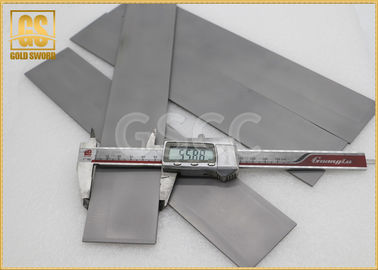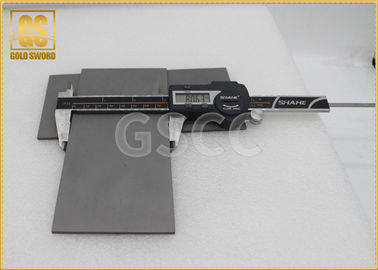Cutting Tools Tungsten Carbide Wear Plates High Thermal Conductivity
Product Details:
| Place of Origin: | Zhuzhou,Hunan,China(mainland) |
| Brand Name: | Gold Sword |
Payment & Shipping Terms:
| Price: | Negotiable |
|---|---|
| Packaging Details: | Carton packaging 15 kg per carton |
| Delivery Time: | 25 days |
| Payment Terms: | TT |
|
Detail Information |
|||
| Usage: | Cutting Tools, Woodworking, Metal Working | Material: | Tungsten Carbide |
|---|---|---|---|
| Application: | Small Inserts, Cutting Tips, Wear Parts | Size: | Customized |
| High Light: | tungsten carbide wear plates,carbide plate stock |
||
Product Description
Tungsten steel is formed by pressing the powder into a billet, heating it to a certain temperature (sintering temperature) in a sintering furnace, and maintaining it for a certain period of time (heating time), and then cooling it down to obtain a tungsten steel material having desired properties.
The four basic stages of the tungsten steel sintering process:
1. Removal of the forming agent and the pre-firing stage, in which the sintered body undergoes the following changes:
The removal of the molding agent, as the temperature increases, the molding agent gradually decomposes or vaporizes at the initial stage of sintering, thereby eliminating the sintered body. At the same time, the molding agent more or less carbon is added to the sintered body, and the carbon addition amount will follow the molding agent. The type, quantity, and sintering process vary.
The surface oxide of the powder is reduced. At the sintering temperature, hydrogen can reduce the oxides of cobalt and tungsten. If the molding agent is removed by vacuum and sintered, the carbon-oxygen reaction is not strong. The contact stress between the powder particles is gradually eliminated, the bonded metal powder begins to recover and recrystallize, surface diffusion begins to occur, and the strength of the compact is improved.
2. Solid phase sintering stage (800 ° C - eutectic temperature)
At the temperature before the liquid phase appeared, in addition to the process that occurred in the previous stage, the solid phase reaction and diffusion were intensified, the plastic flow was enhanced, and the sintered body showed significant shrinkage.
3. Liquid phase sintering stage (eutectic temperature - sintering temperature)
When the sintered body exhibits a liquid phase, the shrinkage is quickly completed, followed by a crystallization transition to form the basic structure and structure of the alloy.
4, cooling stage (sintering temperature - room temperature)
At this stage, the microstructure and phase composition of tungsten steel vary with cooling conditions, and this feature can be utilized to heat treat tungsten steel to improve its physical and mechanical properties.
| GSGrade | ISO Grade | Density (g/cm3) | Hardness (HRA) | T.R.S (MPα) | Grain Size | Performance & Application Recommended |
| RX10 | K20 | 14.6-15.0 | 90~90.5 | 2200~2400 | Medium | High hardness, suitable for roughing of iron, solid wood, dry wood or nonferrous metal, ceramic and other alloys. |
| RX20 | K30 | 14.6-15.0 | 90~90.5 | 2600~2800 | Fine | High toughness, easy to be brazed without heat preservation. Suitable for rosewood, solid wood, pinewood, and other wood with a lot stammer. |
| RX10T | K10 | 14.6-15.0 | 92.5~93 | 1800-2000 | Ultrafine | High hardness, suitable for finishing of iron, nonferrous metal, ceramic and other alloying, semifinishing of of hardwood, chipboard, MDF and HDF. Better to use silver soldering. |
| AB10 | K40 | 13.8-14.2 | 87.5~88 | 2800~3000 | Coarse | High toughness, difficult to break tooth. Special used for finger jointing tool. |






